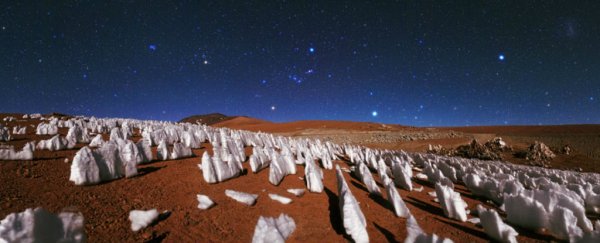We know Mars is a dry, cold, and desolate place, but there's still a chance that the red planet could hold signs of life - in the form of microbial colonies underground. Sure, it's not the picture of a Martian you might have in your head, but it's way cooler than nothing. So, in order to search for these biomarkers, NASA is now testing their new 'life-detection' drill - which is actually a whole series of instruments working together - in Chile's Atacama Desert, one of the most 'Martian' places on Earth.
Dubbed the Atacama Rover Astrobiology Drilling Studies (ARADS) project, NASA researchers are developing a drill that a robot can use to dig down through the Martian landscape in search of tiny, organic molecules. The idea is that if life exists on Mars - or if life existed there before - it most likely went underground as the planet's atmosphere made living on the surface more and more dangerous.
Since testing drills on Mars is out of the question, an international team of more than 20 researchers are currently working in Chile's Atacama Desert, an environment that closely mimics Mars.
"Putting life-detection instruments in a difficult, Mars-analogue environment will help us figure out the best ways of looking for past or current life on Mars, if it existed," said NASA's Brian Glass, the project's principal investigator. "Having both subsurface reach and surface mobility should greatly increase the number of biomarker and life-target sites we can sample in the Atacama."
So far, the team has tested a slew of different technologies that might one day hitch a ride to Mars. Some of these prototypes include a drill, a sample transfer arm, the Signs of Life Detector (SOLID), and the Wet Chemistry Lab (WCL). Basically, all of these prototypes will work together to probe the Martian surface in search of microbial life.
The ARADS drill will dig up soil samples and the transfer arm will feed these samples to SOLID and WCL for analysis. Though this sounds simple for a group of researchers who work for an organisation that has already put a person on the Moon and sent a probe into interstellar space, nothing is easy on Mars, especially since it's nearly impossible to fix any issues that might arise once the instruments land on the planet.
Besides making the physical instruments needed for the mission, the researchers are also developing new ways to search for microorganisms that can thrive inside rocks and extremely dry climates. Finding ways to accurately study these colonies will be necessary before the instruments can see real use in NASA's quest to find alien life.
The team will take the next four years to completely figure out these new systems. The goal in Atacama is to demonstrate that their instruments and theories are valid before embarking on the costly process of sending them to Mars. If all goes well, SOLID may be the instrument that allows researchers to declare that there is life on Mars once and for all.
